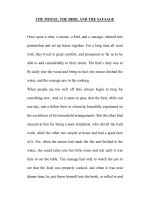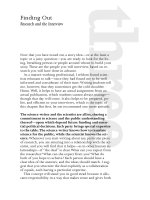adam de la halle and the ars antiqua time period
Bạn đang xem bản rút gọn của tài liệu. Xem và tải ngay bản đầy đủ của tài liệu tại đây (25.68 KB, 1 trang )
Adam De La HalleArs Antiqua Time PeriodLife SummaryAdam de la
Halle is often referred to as the greatest of the long succession of post
Medieval musicians. He was a poet, musician and innovator of the
earliest French theater. He became famous for his use of polyphony and
his theatrical productions. Adam originally trained for the clergy (the
people of the church). Marriage interfered with his musical career; but
with the help of some noble benefactors he was able to pursue musical
studies at the University of Paris. The remainder of his life was spent in
service of noble patrons. His MusicAdam de la Halle was of French
origins. All of his lyrics were written in French. Much of his early music
was monophonic which shortly after became homophonic and then
transformed into polyphonic. Much of his polyphonic work was set for 3
voices or instruments. If a piece of music is monophonic, then it has only
a melody line and no harmony. Much of the medieval music was
monophonic. If the music is homophonic then there is only one melody
line, but it may be played by two or more instruments. Many of the songs
that were originally monophonic were easily transformed into homophonic
by add extra voices or instruments. Polyphonic is the type of music we
hear today. Polyphonic is when there is a melody line accompanied by
harmony. A considerable amount of Adam de la Halle's polyphonic work
was designed for plays. One of Adam's manuscripts contains the oldest
known existence of the sharp sign. In 1872 his music was officially
published. Ars Antiqua Time PeriodArs Antiqua is Medieval Latin for
"ancient art". Ars Antiqua was the period of musical activity in 13th
century France. The music was characterized by the increasing
sophistication of counterpoint (the art of combining simultaneous voice
parts). Modern music historians classify the whole 13th century as Ars
Antiqua where as older historians classified only the later half of the 13th
century as Ars Antiqua. This was the time period when music started to
become more formal. In this time period, musical plays were just
becoming popular and in 1283 one of the first operas was performed.
Most of the music of the Ars Antiqua time period is anonymous. Two
important figures stand out among the anonymity. Pérotin, who became
famous in the late 12th century, composed the earliest known music for
four voices. Franco of Cologne, who flourished in the middle of the 13th
century, was a theorist who organized a new, more precise system of
rhythmic notation, the direct ancestor of modern notation. The most
important style of music to originate in the Ars Antiqua is the motet, which
retained its popularity for centuries. The essence of this style of music is
the simultaneous presentation of more than one text. It originated with the
addition of a new text to the upper voices of a sacred polyphonic
composition. The lower, slower moving voices retained the original text.
Ars Antiqua was the time period when music as we know it was just
beginning. Composers were considered innovators because they
invented a great deal of what is used in modern music (for example
harmony and modern notation). The music we listen to today is
comprised of everything these composers created. Without this great
musical minds, music today would be significantly different.









